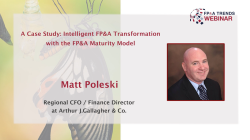FP&A teams have played a critical role in organisations for a long time. However, traditional FP&A is no longer sufficient. Economic volatility, shifting demographics, emerging technologies, and data overload demand a more agile, insight-driven FP&A. This paper explores what makes modern FP&A teams effective, outlines four essential layers to meet today’s business needs and provides practical steps to implement them.
In this article, the author explains how to overcome the challenge of not spending enough time for true finance business partnering and driving real value creation. He also shares a case study of leveraging the FP&A Trends Maturity Model.
This article offers food for thought on transforming a team towards Advanced FP&A using the FP&A Trends Maturity Model and examples derived from a €1 billion+ revenue company specialising in leasing and renting road freight and intermodal transport equipment.
Matt Poleski, Regional CFO at Arthur J.Gallagher & Co., shares his experience using the FP&A Trends Maturity Model. In his case study, Matt deep-dives into why and how they structured their team's overperformance and what they could improve.
If you are wondering where to start with your finance transformation and not sure whether the focus should be on data, systems or Business Partnering, consider implementing Rolling Forecasts. In this article, the author outlines six practical steps to get started with Rolling Forecast.
Join the FP&A Trends Webinar on April 17th at 8:00 AM PDT / 4:00 PM BST to discover how finance teams can shift from reactive, static planning to real-time scenario planning to drive greater enterprise value, by modeling multiple scenarios instantly, identifying potential risks and opportunities and making faster, more informed decisions.
Pagination
Subscribe to
FP&A Trends Digest

We will regularly update you on the latest trends and developments in FP&A. Take the opportunity to have articles written by finance thought leaders delivered directly to your inbox; watch compelling webinars; connect with like-minded professionals; and become a part of our global community.






